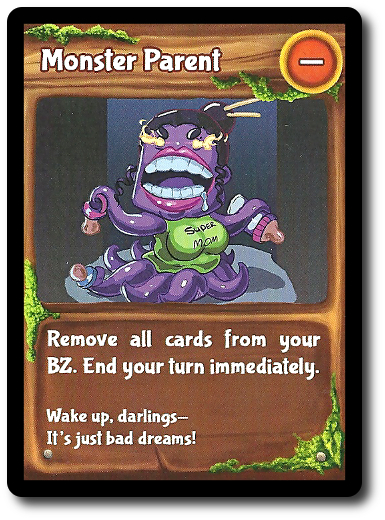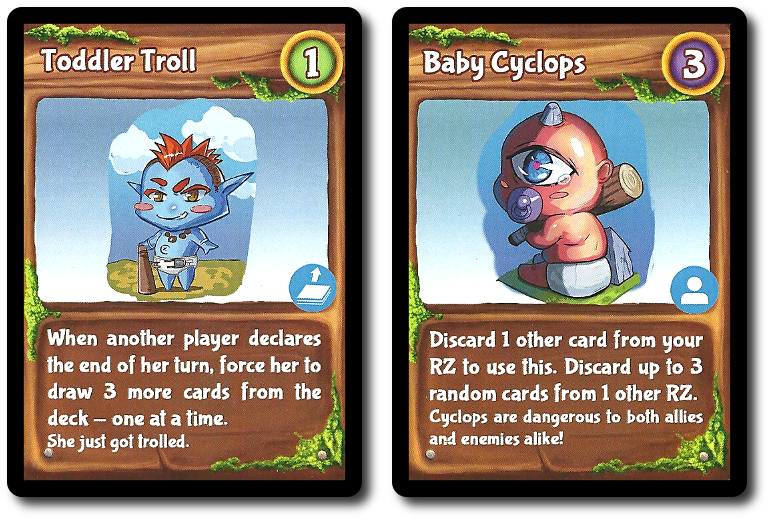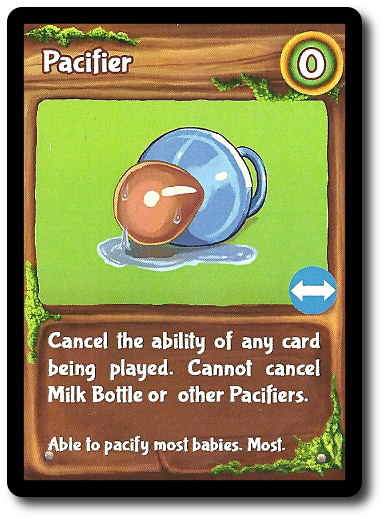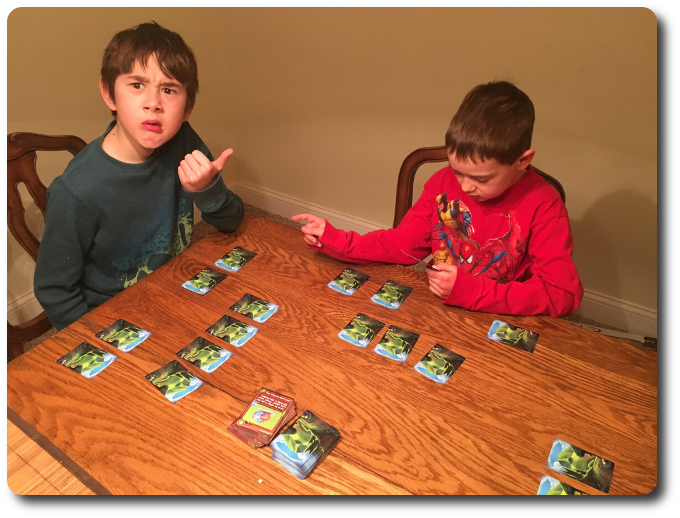Please Take Note: This is a review of the final game, but it might change slightly based on the success of the Kickstarter campaign. The game is being reviewed on the components and the rules provided with the understanding that “what you see is not what you might get” when the game is published. If you like what you read and want to learn more, we encourage you to visit the publisher’s website or visit the Kickstarter campaign. Now that we have all that disclaimer junk out of the way, on with the review.

The Basics:
- For ages 8 and up
- For 2 to 6 players
- Approximately 15 minutes to complete
Geek Skills:
- Counting & Math
- Logical & Critical Decision Making
- Reading
- Strategy & Tactics
- Risk vs. Reward
- Hand/Resource Management
- Bluffing and Misdirection
Learning Curve:
- Child – Easy
- Adult – Easy
Theme & Narrative:
- Monster babies are more dangerous when they are asleep
Endorsements:
- Gamer Geek rejected!
- Parent Geek approved!
- Child Geek approved!
Overview
When baby monsters sleep, they dream of conquest! They wage epic battles against other babies, steal pacifiers, and spill milk bottles. But sleeping babies should be careful. If they make noise, their parents will wake them up, incorrectly believing they are having a nightmare. To keep having fun, dream boldly, but with caution. You don’t want to be caught with your diaper down.
Little Monsters, designed and to be self-published by Dominic Huang, will reportedly be comprised of 100 cards. As this is a review of a prepublished game, I cannot comment on the component quality. Early sample artwork portrays the monsters in the game as adorable little babies that you would never ever consider slaying. Don’t be fooled by those big eyes and droopy diapers. These little tykes pack a punch.
Welcome to the Nursery
To set up the game, first shuffle all the cards and place them face-down in the middle of the playing area to create the draw deck.
Second, determine who will be the first player.
That’s it for game set up. Time to babysit some little monsters.
Beasts and Babies
Little Monsters is played in rounds and turns with no set number of rounds per game. A game turn is comprised of several sequential phases, which are summarized here.
Phase 1: Drawing and Playing Cards
Starting with the first player and continuing in turn order sequence, each player will take 1 or more actions.The player can decide to end their turn during this phase. If the Monster Parent card is drawn, they are forced to end their turn and must wait for phase 2.
The actions available are as follows:
Gather
This action allows the player to take the top-most card from the draw deck and add it to their hand. This action can be taken as many times as the player likes, stopping only when they want to or if they draw a Monster Parent card. All drawn cards should be kept hidden from opponents unless the drawn card is a Monster Parent.

A Monster Parent must be revealed and played face-up as soon as it’s drawn, ending the current phase for the player. Any cards in the Baby Zone are discarded. Cards in the Keep and Ready Zone are not discarded.
If a player does not have any cards in their Baby and Keep Zone, the Monster Parent has no effect.
Form
Cards can be scored for Baby Points by playing them face-down in a row in front of the player. This area is referred to as the “Baby Zone”. The placement of cards in this zone is referred to as “Forming”, which is meant to represent the organized deployment of babies to wage war against opponents’ babies. Placement of cards in the Baby Zone does not trigger any card abilities. Only the Baby Points will be used on the cards.

Most baby monsters provide Baby Points (the number in the upper-right corner) and an ability – choose wisely
Cards that do not have Baby Points can be placed in the Baby Zone. While these cards will not provide any Baby Points to assist the player, they can be used to bluff opponents. A good tactic to trick an opponent into taking more risk to find cards, but the player might also want to consider the benefits of using the card for its listed ability.

Keep
If a player doesn’t want to score a card for Baby Points, they can hold it for use later. Cards that are kept can be used for their listed ability. Keeping a card allows the player to place it face-down in front of them and just behind their Baby Zone. This area is referred to as the “Keep Zone”. The Keep Zone should be to the left of the player and all cards within this zone should be tipped sideways. Cards played to the Keep Zone cannot be used until the next round.
Phase 2: Tally and At the Ready
Players who were unceremoniously ejected from phase 1 due to a Monster Parent card still participate in phase 2.
All players now reveal their cards in the Baby Zone. Baby Points are tallied. The player with the highest number of Baby Points has won the round.
All cards in the Baby Zone are collected and discarded. The player who won the round is the first player in the next round.
All cards in the player’s Keep Zone are now moved to the right and behind the Baby Zone. This area is referred to as the “Ready Zone”.
Cards in the Ready Zone can be used by the player for their ability when the player thinks it would be most beneficial. The card they want to use is revealed, read out loud, and then resolved. Once resolved, it’s discarded. Additional cards can be brought into the player’s Ready Zone by moving cards from the Keep Zone at the end of the round. If a baby monster is located in the Ready Zone, its Baby Point value is ignored and only the ability text is used.
Winning the Game
The game continues until 1 player has won 2 rounds. The rounds do not need to be won in row.
Game Variant
The game comes with one variant titled “Monster Mama”. This game variant is meant only for 2 players and introduces a 3rd non-player that acts as the Monster Mama. Players act on the Monster Mama’s behalf and always place drawn cards to the Baby Zone. If the Monster Mama wins 2 rounds, the players lose. I should note that you can play Little Monsters without using this game variant if only 2 players are available.
To learn more about Little Monsters, visit the publisher’s website or visit the Kickstarter campaign.
Final Word
The Child Geeks really enjoyed themselves. They found the game to be intuitive and liked how they were able to play cards to bluff their opponents. Most importantly, they liked the rewarding feeling of digging deeper into the draw deck and watching others draw the dreaded Monster Parent. According to one Child Geek, “The game is all about how much you want to risk. More cards in play means a bigger chance to lose it all!” The Child Geeks even used the special abilities well enough to make the Ready Zone a place of danger and uncertain outcomes. As one Child Geek put it, “What I put here will hurt you later. FEAR IT!!!” All the Child Geeks voted to approve Little Monsters.

The amount of baby smack downs was unprecedented and brothers quickly became enemies
The Parent Geeks found the game’s theme to be cute and funny, but the game itself was not something they thought they would play with their peers. As one Parent Geek put it, “I like the game and I like the art, but it’s just not a game I would get out if I was having other adults over for dinner.” As a family game, the Parent Geeks thought Little Monsters was perfect. According to one Parent Geek, “The game is fast, fun, easy to teach, easy to play, and does a great job of balancing luck with skill. Perfect for a family game.” So perfect, in fact, that the Parent Geeks overlooked their initial doubts and gave the game their full approval.
The Gamer Geeks were impressed with how the game handled hidden information, risk taking, and the need to make strategic and tactical choices about where to put cards. One Gamer Geek said, “I think this is a very well made game and one that’s worth playing.” But not all the Gamer Geeks were impressed enough to suggest that the game itself was worth playing by elitists. As one Gamer Geek put it, “This is a great game for kids and for families. I doubt very much that any serious gamer would sit down and want to play a game about baby monsters in diapers for any length of time.” The Gamer Geeks were divided on this point. One side of the group wanted to approve the game based on its game play and good design, while the other side wanted to reject the game due to it not being difficult or deep enough for a veteran gamer to feel challenged and satisfied by the game playing experience. The end result was a rejected approval from the gaming elitists, despite the game having its supporters.
I don’t believe I’d play Little Monsters with anyone but my kids, their friends, and adults with kids. The game is good, but fails to meet my expectations as a game I would want to play with adults. This is not a bad thing whatsoever, but it also limits your playing group to a certain extent. That being said, there were Child Geeks who played Little Monsters and hated it and Gamer Geeks who loved it. The only group that remained consistently positive were the Parent Geeks.
The best part of the game is the bluffing. Playing card after card in front of you tells the other players that you are looking to score some major Baby Points. Since a player need only win 2 rounds to claim victory, each round is hotly contested. This is where the bluffing comes into play, as you can trick you opponents into taking risk. The more cards they draw, the better the chance of drawing a Monster Parent. Do that and the round is lost. This creates tension which is intermingled with the growing anticipation of revealing the Baby Zone.
Little Monsters is light, fast, and fun. I would recommend it to any family who is looking for a card game that can be played by a wide age range and will most certainly challenge players to think things through. The game play itself is straightforward, but the game’s difficulty is based on an opponent’s craftiness. If you are looking for a game where bluffing is mandatory, misdirection is commonplace, and babies punch each other, do play Little Monsters. Just don’t come crying to me when you lose.
This is a paid for review of the game’s final prototype. Although our time and focus was financially compensated, our words are our own. We’d need at least 10 million dollars before we started saying what other people wanted. Such is the statuesque and legendary integrity of Father Geek which cannot be bought except by those who own their own private islands and small countries.



